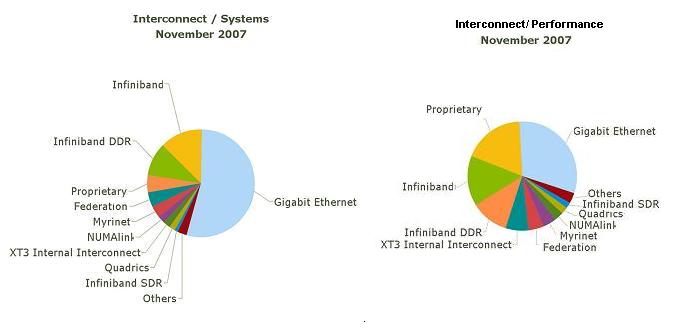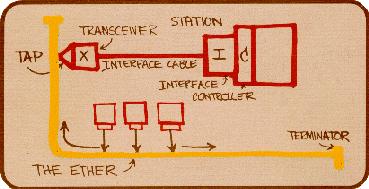CSC/ECE 506 Fall 2007/wiki4 001 a1: Difference between revisions
| Line 32: | Line 32: | ||
== Infiniband == | == Infiniband == | ||
Infiniband is a technology that runs on top of TCP/IP. | Infiniband is a technology that runs on top of TCP/IP, operating in the "Data Engine Layer" below upper layers over which client communications take place. To reduce TCP/IP latencies, a large portion of the TCP/IP protocol stack execution is offloaded onto the client's ethernet NIC card. A subnet of switches and end users can communicate to any other Infiniband subnet via TCP/IP. | ||
The standard Infiniband data packet is defined as follows: | The standard Infiniband data packet is defined as follows: | ||
| Line 39: | Line 39: | ||
LRH - Local Route Header, GRH - Global Route Header, BTH - Base Transport Header, ExTH - Extended Transport Header, Immediate Data Header, Msg Payload - Message Payload, I-CRC - Invariant CRC (32-bit) (Not used for Raw datagram), V-CRC - Variant CRC (16-bit) | LRH - Local Route Header, GRH - Global Route Header, BTH - Base Transport Header, ExTH - Extended Transport Header, Immediate Data Header, Msg Payload - Message Payload, I-CRC - Invariant CRC (32-bit) (Not used for Raw datagram), V-CRC - Variant CRC (16-bit) | ||
[[Image:jdbramanpic4.jpg]] | |||
[[Image:jdbramanpic5.jpg]] | |||
== Infiniband DDR == | == Infiniband DDR == | ||
Revision as of 00:07, 29 November 2007
Current Supercomputer Interconnect Topologies
Gigabit Ethernet
Ethernet is defined by IEEE Standard 802.3. It is implemented by networking protocols that allow 1GB of data to be transfered at a speed of up to 1 GB per second. 1 GB Ethernet is currently being replaced in the marketplace with the faster 10GB Ethernet. The standard defines the use of data frame collision detection rather than collision avoidance. CSMA/CD is used to describe the method Ethernet protocols allow communication. This stands for Carrier Sense Multiple Access with Collision Detection. If two stations operating Gigabit Ethernet send data frames which collide, the following protocol is followed according to Standard 802.3:
Main procedure 1. Frame ready for transmission. 2. Is medium idle? If not, wait until it becomes ready and wait the interframe gap period (9.6 µs in 10 Mbit/s Ethernet). 3. Start transmitting. 4. Does a collision occur? If so, go to collision detected procedure. 5. Reset retransmission counters and end frame transmission.
Collision detected procedure 1. Continue transmission until minimum packet time is reached (jam signal) to ensure that all receivers detect the collision. 2. Increment retransmission counter 3. Is maximum number of transmission attempts reached? If so, abort transmission. 4. Calculate and wait random backoff period based on number of collisions. 5. Re-enter main procedure at stage 1.
The most common Ethernet frame format (Type II) includes bits for source MAC address, destination MAC address, ether type, payload, and checksum. MAC (Media Access Control) is a layer 2 protocol that works below the Ethernet 802.2 LLC (Logical Link Control) and above the physical layer in most network topologies. Ethernet interfaces with MAC and LLC in the data link layer below the network layer. The following is a diagram Etherent data frame format:
Supercomputers connected by Ethernet can choose to use on of many physical layer links and network layer types. TCP/IP is the most common network layer implemented worldwide which is why gigabit Ethernet is so prevalent. Less modification has to take place for usability in large scale supercomputer networks. Many of the other most implemented supercomputer interconnects are simply custom implementations of the network layer type. This is done to speed up Ethernet LAN clusters running on the data link layer since TCP/IP can have too much latency and poor reliability.
Infiniband
Infiniband is a technology that runs on top of TCP/IP, operating in the "Data Engine Layer" below upper layers over which client communications take place. To reduce TCP/IP latencies, a large portion of the TCP/IP protocol stack execution is offloaded onto the client's ethernet NIC card. A subnet of switches and end users can communicate to any other Infiniband subnet via TCP/IP.
The standard Infiniband data packet is defined as follows:
LRH - Local Route Header, GRH - Global Route Header, BTH - Base Transport Header, ExTH - Extended Transport Header, Immediate Data Header, Msg Payload - Message Payload, I-CRC - Invariant CRC (32-bit) (Not used for Raw datagram), V-CRC - Variant CRC (16-bit)
Infiniband DDR
Federation
Myrinet
Myrinet is a platform developed by Myricom to run on Ethernet LAN clusters that provides 5-10 times lower latency than Ethernet over TCP/IP. Users of Myrinet interconnects include the University of Illinois, Indiana University, the University of Southern California, Vanderbilt University, and Los Alamos National Laboratory.
NUMAlink
XT3 Internal Interconnect
Quadrics
Infiniband SDR
Sources
[1] top500.org interconnect usage (Share %), performance statistics (Rmax Sum)
[2]IEEE 802.3 Ethernet Standard
[3] Ethernet protocol summary on Wikipedia
[4] Myrinet article





